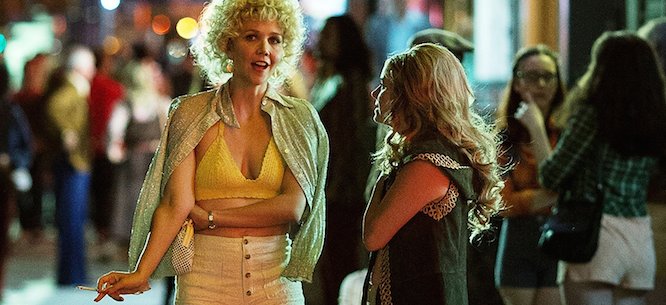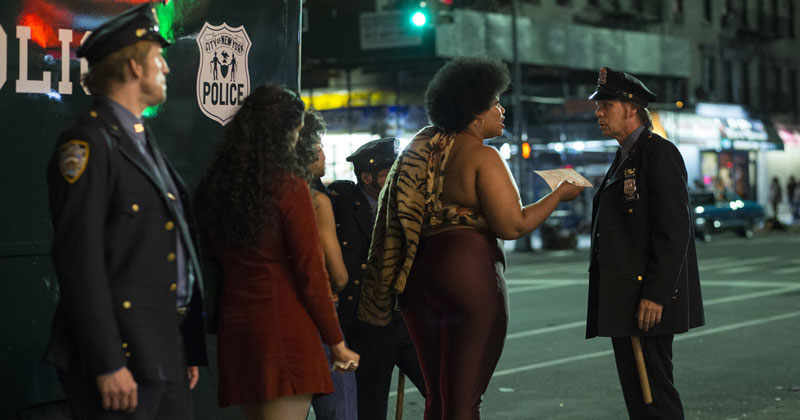Working the Deuce
Working the Deuce
The Deuce, at its best, offers a 360-degree view of New York’s sex economy—but as the show progresses, Times Square’s street characters become a sideshow.

The sun comes up over a Manhattan apartment. It’s the early days of summer 1971, and the occupant, a sleepy young woman, has opened up her bookkeeping after a night’s work. She tallies up cash from each customer: $30 for the half-hour (plus $10 for the room), negotiated curbside along West 42nd Street. She splits her earnings across a series of white legal-sized envelopes. One is marked for her mother.
Maggie Gyllenhaal, the actor playing Candy (or Eileen, her given name) in this scene midway through the pilot episode of The Deuce, told reporters that to prepare for this part, she talked to real-life prostitutes (a word rarely uttered on the show, but that in the early seventies would have been the vernacular, not sex worker, as is more common today). This envelope method of accounting is real, as real as the sugar babies and strippers who recommend this practice still. So there’s every reason to believe that for Gyllenhaal, this scene wasn’t meant to portray some traumatic math, a record of “selling her body.” It is not sordid; it’s just a shift’s end.
It’s hard to say, however, how series creators David Simon and George Pelecanos regard this clocking-out. Simon and Pelecanos used the outcasts of Times Square to sell The Deuce, an eight-episode television series with a second season already on the way, to HBO. And this focus on street characters and their point of view serves the show well, to begin with. The Deuce, at its best, dwells in the ordinary social exchange of Times Square life: pimps and police rubbing shoulders at the shoeshine stand, working girls swapping gossip on smoke breaks and in diners over plates of hash and eggs, a reporter complaining to her editor that when he cut her lede he just let the city off the hook. It’s a 360-degree view of New York’s sex economy—much like Simon’s portrayal of Baltimore’s drug trade in The Wire, from station house to shipping docks, courtroom to newsroom.
That sounds like a living neighborhood, but it’s one that won’t exist by the season’s end. The further into The Deuce you go, the further you get from the independent, tight-knit crew of women selling sex at the center of show. The women who populate these stories recede like a light in the rearview, fading into the streets. In their place is greed, domination, and violence, like they were never there.
The unacknowledged source material for the journalism and policing plot lines of The Deuce is the work of New York magazine journalist Gail Sheehy, who in the early seventies was associated with New Journalism and who published several feature stories on Times Square and its sex trade. Sheehy loitered at lunch counters and hotels, turning a night guard at the Waldorf into a source she believed would help her “understand the life cycle of a streetwalker.” Once on a tip from a dive hotel operator she slid her tape recorder under a working girl’s bed. The chapter of Sheehy’s memoir recounting this episode, “Redpants and Regrets,” does not state if she had the sex worker’s consent to record her appointment. She says Tom Wolfe sent her a fan note, which read in part, “Thank you for being the hooker’s Boswell!” More features followed covering the same terrain; Sheehy received more than one New York Newswomen’s Front Page award.
When Sandra Washington, The Deuce character drawn from Sheehy herself, first tries to cover the Times Square sex trade, she starts with the women who sell sex. A prostitute named Darlene is taking a few minutes for herself at the bar where the pimps hang out, commingling with gamblers and hardhats. Sipping a glass of white wine, Darlene reads A Tale of Two Cities, alone. Sandra takes this as an opening, but we see her approach from Darlene’s point of view: just another stranger mistaking her drinking and reading by herself as an invitation for company. Sandra reads Darlene’s skepticism when she fumbles her story pitch—describing herself as “like an anthropologist”—as caginess. Sure enough, her pimp is watching, and breaks in, not threatening anything, just throwing his weight around. Darlene’s reaction is to eye-roll, like she will again not long after this, when a bartender scolds her for not using a bus ticket she had bought her to help Darlene escape Times Square.
Darlene rejects the offer to tell her story, just like she turns her back on her would-be saviors. What does motivate her, propelling her across the city in too-loose heels, is tracking down the peep show playing her porn debut, a film made by a customer, and one which she never consented to having recorded and sold. Her porn hunt comes at a turning point in the sex trade, the moment that organized crime sees opportunity in consolidating the porn and massage parlor business into their pockets, when landlords and lawyers who are willing to look askance see the opportunity to indirectly profit from them with steep rents collected through shell companies. Candy transitions into porn, first performing and then directing, while most of her former circle is still out waiting in the cold for $30 dates. By the closing episode, Candy is in a taxi on the way to a launch party for a porn film, passing the girls on the streets, their sequins and satin blurred by the neon lights on the other side of the window.
Porn on The Deuce is Candy’s escape from the streets, from the precarity of selling sex in half-hour increments to booking day-long gigs, and from the risks of being alone with a customer to the camaraderie of a film set. For a show that draws on the shifting conditions under which sex is sold for its narrative fuel, the series is ultimately more concerned with the sex industry as a symbol for exploitation. “What I stumbled into seemed to be a ready-made critique of market capitalism, and what happens when labor has no collective voice,” David Simon told the Guardian. “The characters, the world and some of the themes that began to emerge, that really appealed to me in terms of labor and capital and the product being itself the laborer: flesh is the commodity here. And how the money and the power array themselves and how they don’t.”
He also added:
I don’t think you can look at the misogyny that’s been evident in this election cycle, and what any female commentator or essayist or public speaker endured on the internet or any social media setting, and not realize that pornography has changed the demeanor of men. Just the way that women are addressed for their intellectual output, the aggression that’s delivered to women I think is informed by 50 years of the culturalisation of the pornographic.
Advances in women’s rights in the workplace since the 1970s, fractured and incomplete as they are, take a backseat—for this powerful male producer of prestige television—to the “culturalisation of the pornographic.” For Simon, the sex worker is the porn product, and the porn is to blame, not the sexism that preceded and, in part, produced the porn industry.
Maybe Simon is fearful that any depiction of the sex industry will necessarily be read as either a condemnation or a co-sign, and so he must at least appear to choose a side. Maybe he just read a feminist blog on the politics of Playboy from 2005 to prepare for the press circuit. He’s found the right jargon, anyway, to capture the kind of sex industry that could flourish under neoliberalism, but he doesn’t know what’s really being sold. Is it the pornographic picture that corrodes, or the conditions under which it was produced? The woman in the photo may look degraded. She may look innocent. That tells us nothing about how much power she had in its making, or in the rest of her life. Flesh is not for sale; she goes home with herself after.
The Deuce is not even a story of the people in prostitution and porn, or of porn corroding America; it’s a story of those who wouldn’t deign to touch the stuff turning up when there’s cash to be made, pushing out everyone who took the risks that made the business attractive to them. As organized crime and law enforcement alike conspire to force the street trade indoors, we see the squeeze on the characters we’ve seen struggle already. While white street workers transition to parlor work and porn production, black sex workers are undermined by parlor management, who try to talk customers away from them, and ignored by porn producers trying to upscale their only recently not-so-illicit product. Even Candy, the most independent of the street sex workers turned ambitious porn director, could soon be swept aside in favor of the bored housewife she encounters in her producer’s office, curious about how people break into the movies. The final image of the season’s final episode tracks the corridor dividing private rooms where sex is sold in the massage parlor, the women hidden behind closed doors.
Once, as author Samuel Delany captured it in his companion essays, Times Square Red, Times Square Blue (1999), that neighborhood could contain the diners and the newspaper stands and the sex shops and short-stay hotels. Times Square was a working-class playground linking the center of the city to its surrounding neighborhoods, going back at least as far as a century ago when the New York Times moved there and lent it its name. Times Square is about contact, Delany writes, across class, across gender, across race and sexuality, and the new city that would arise there could only entertain so much of that. Delany was once accused by Marshall Berman of harboring too much attachment to what Berman called “the pre-AIDS golden age of hustling.” However, as Delany writes, “If there was any such ‘golden age,’ I never had any experience of it, nor was I aware of any such thing at the time. (I assume he must mean pre-1982, possibly pre-’84.).” Simon and Pelecanos used nostalgia to sell their show, while also insisting the result would not glorify or sensationalize Times Square and its sex trade. How can they have nostalgia for what never was?
All those people who found refuge and survival in a place like Times Square are the draw for viewers of The Deuce, but it is clear after the series’ first eight episodes that they are a sideshow. When sudden and extreme violence hits the community of street sex workers, we do not get one reaction from any of those women. Instead, a bland young New York University drop-out slumming her way through the neighborhood offers her commentary, and a cop punches a pimp for not taking the incident gravely enough. Maybe this violence is there to signal the party is over. The Times Square we are left with offers prostitution without prostitutes.
Melissa Gira Grant is a journalist and the author of Playing the Whore: The Work of Sex Work (2014).







